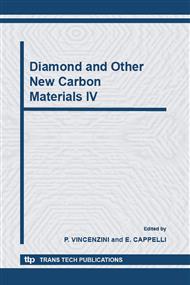p.1
p.9
p.17
p.24
p.31
p.37
p.44
Effect of Bias Voltage on the Physical Properties of Hydrogenated Amorphous Carbon Films Grown by Electron Cyclotron Resonance Chemical Vapour Deposition
Abstract:
In the present work, a-C:H films have been grown from argon/methane gas mixtures by Electron Cyclotron Resonance Chemical Vapour Deposition (ECRCVD). The effect of the application of a dc bias voltage to the silicon substrate material on the structural, morphological and mechanical properties of the films has been explored by multiple analysis techniques such as IR and micro-Raman spectroscopy, AFM, nano-indentation and pin-ondisk wear testing. In general, within the range of –300 V to +100 V applied substrate bias we have observed a strong correlation between all measured properties of the grown a-C:H films and the ion energy. Though it is known that the ion energy is one of the crucial parameters in plasma grown films, this work clearly shows that the properties of the a-C:H layers can differ greatly and indicates a threshold energy for the production of hard, low-friction coatings in the order of 80-90 eV. Moreover, this threshold energy is also combined with a sharp transition from rough, cauliflower-like film surfaces towards ultrasmooth, featureless topographies. This correlation suggests that at energies higher than 80 eV the ion bombardment affects simultaneously the surface morphology and the internal bonding structure.
Info:
Periodical:
Pages:
17-23
Citation:
Online since:
October 2006
Keywords:
Price:
Сopyright:
© 2006 Trans Tech Publications Ltd. All Rights Reserved
Share:
Citation:


